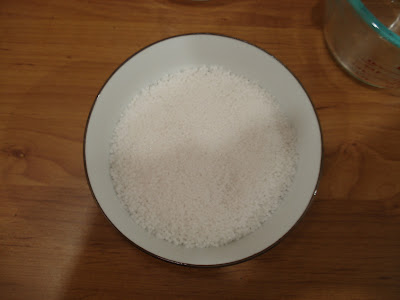I made a new batch of soap on the weekend. It's the olive, rice bran, coconut oils mix I usually make but soap may be made with many different oil blends so be guided by a soap making book, if you have one, or any number of the excellent soap making sites on the web. Once you find a blend that works well for you, stick with it; I am sure that soap will serve you well for many years.
Bowl of measured caustic soda granules.
One thing I always find when I write about soap is that while many people know how to make good soap, there are always a large number who want to, but hesitate, saying the danger or caustic soda is their stumbling block. On Friday, Helen said that after googling caustic soda she found it is used as paint stripper so she doesn't want to use it. Let me say this plainly: ALL soap, even the 'natural' soaps you might buy for five dollars a bar are made using lye or caustic soda. You cannot make cold pressed soap without using lye or caustic soda. Lye and caustic soda are the same thing and when they go through the process of saponification, they are neutralised and turn into soap. I use Sodium hydroxide (NaOH) to make bar soap and Potassium Hydroxide (KOH) to make liquid soap - both substances are caustic. I will write more about the small danger associated with making soap tomorrow, but for now, let's concentrate on the process. The recipe I used and the process are the same as that in my tutorial, which is here.
Pour the caustic soda into the water, not the other way around.
I have broken soap making down into a few different parts:
- Preparation
- Getting the temperature right
- Mixing
- Moulding
Preparation
You need to prepare the area you'll work in. Caustic soda can burn you, your bench tops or anything else it comes in contact with when it's wet. The granules of caustic soda are fine until you add water, even a moist hand will start a burning reaction. Please follow these steps:
- Open the windows to allow good ventilation. There is a short period after you mix the caustic soda and water together when you will smell fumes. Good ventilation is essential.
- Make sure there are no children or animals around.
- Make sure you have a clean and clear area to work in.
- You'll need measuring jugs, a stainless steel, plastic or wooden spoon, candy or milk thermometer, saucepan, accurate scale for measuring your amounts, mixer or stab blender and your mould.
- Have everything ready and measured before you start.
Getting the temperature right
- To make soap you add water to a jug and add caustic soda to the water - not the other way around, it splashes too much. As soon as you mix the caustic soda and water together they will start to heat up. You don't have to add heat, the water and caustic soda alone create their own heat. This mixture will heat up to about 80C/170F and after you mix it well so it's dissolved, you'll have to wait for it to cool down again. Mix the caustic soda and water first. You want the caustic soda and water to cool down to around 50C/125F.
- You also have to mix your oils together and heat them up on the stove. Heat to around 50C/125F - you need the caustic soda and the oil to be around about the same temperature. When they are, mix them together. Pour the oil into your mixing bowl first, then add the caustic soda.
Have everything measured and ready before you start.
Mixing
- Mix until you reach trace. Trace is when the soap has thickened and when you drizzle the soap from the mixer onto the top of your mix, it will leave traces that don't disappear into the mix..
- Mix gently at first until the oil and caustic have blended, then increase your speed. Yesterday, my soap took about 10 minutes to reach trace. The time will be different each time because it depends on the temperature and the oils used.
This is what trace looks like - instead of a smooth top, the ripples stay on the top.
Moulding
After you reach trace, pour the mixture into a suitable mould. It can be a plastic resin cake tin, such as the one I use, or small moulds for individual soaps, or a clean milk carton. Don't use aluminium. At this point, try to retain the heat in the soap by wrapping it up in towels. It should be ready to unmould the following day and then you can cut the soap into the size bar you would like.
Wrap up the soap in towels to retain the heat.
Soap making is a very useful skill that I encourage you all to develop. Even though it has elements that might be dangerous, with care and concentration, you will be able to do it. When you've made one batch, you'll understand the dangers and realise it's straight forward and easy, as long as you prepare well and follow the steps. Tomorrow I'll be writing about how we have been removed from old homemaking skills and scared into believing we have to rely on commercial enterprises to 'save' us. It's an important topic so I hope you'll come back to read it.







